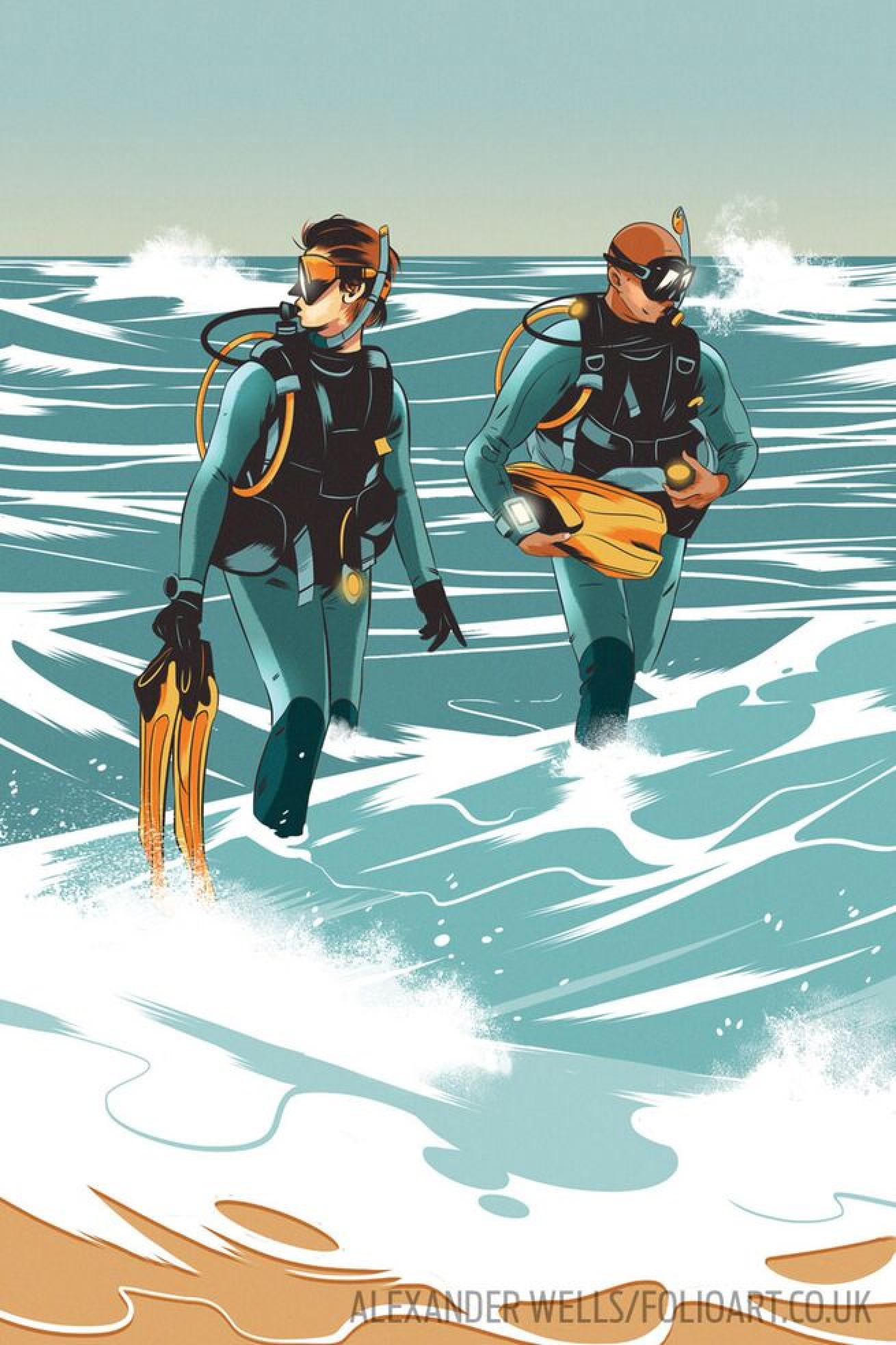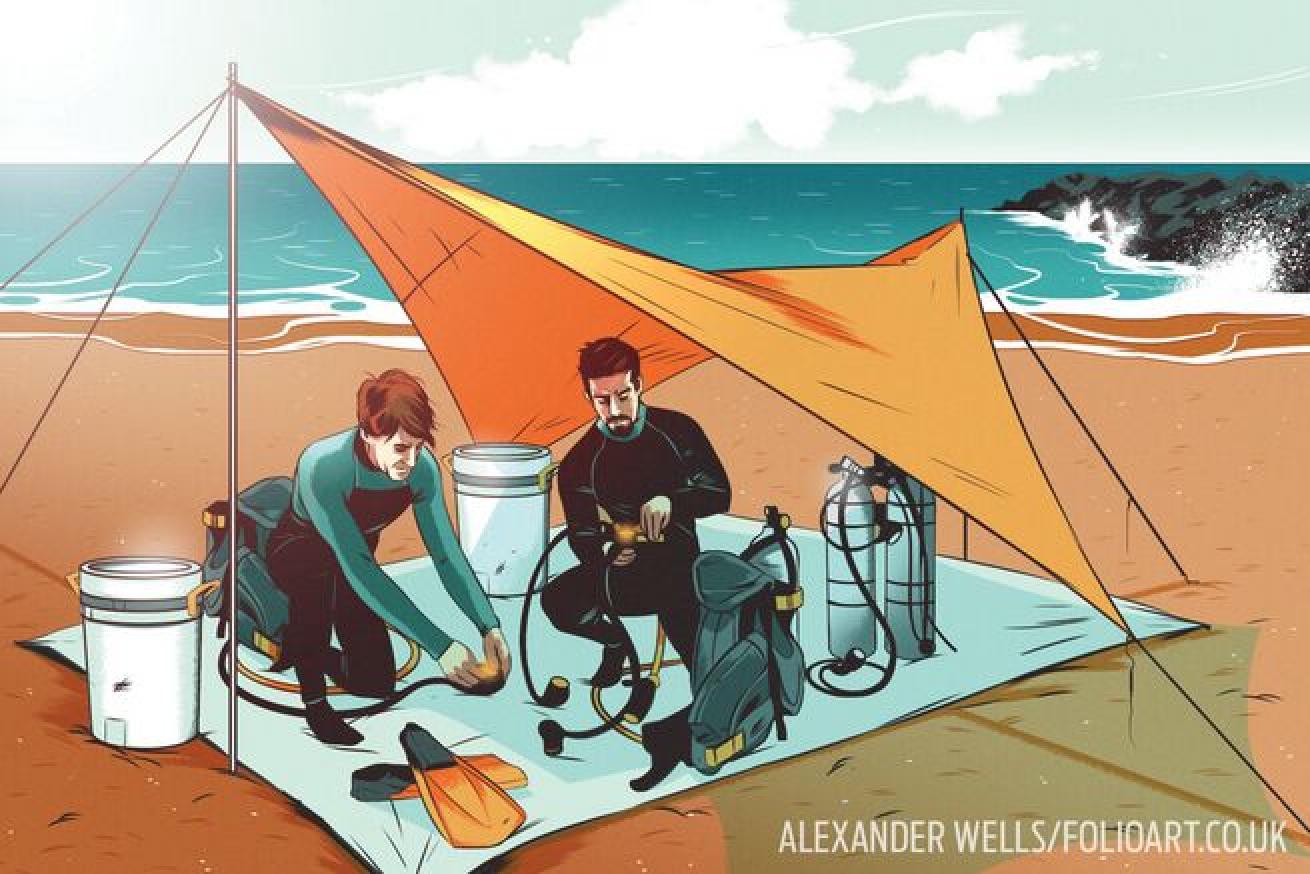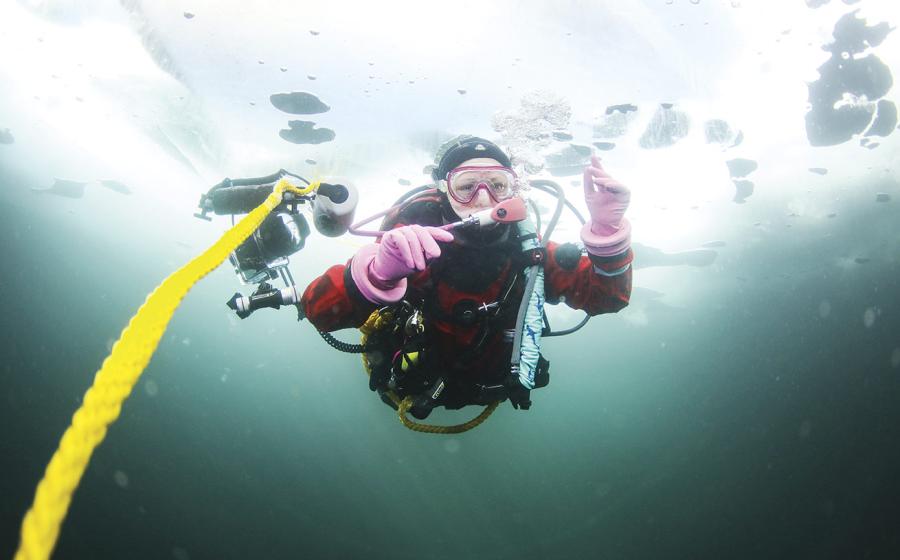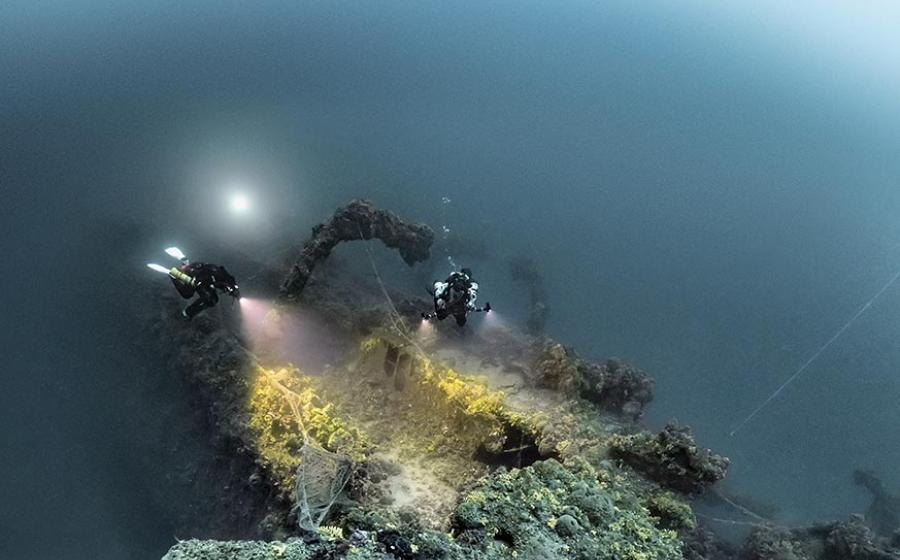How to Safely Scuba Dive from Shore
Rule No. 1 when you dive from shore: Be prepared.

Alexander Wells/folioart.co.ukWhen the surf is rough, enter the water by walking backward, looking over your shoulder so you can prepare for large waves.
Eric Douglas and his dive buddy had dived Laguna Beach’s Shaw Cove dozens of times, entering and exiting without any issues. The pretty cove is beloved by divers for its easy beach access, and marine life — garibaldi, sheephead and harbor seals.
After one dive, the experienced pair “got too shallow, and we ended up getting tossed into the surf zone on top of rocks,” says Douglas. Suddenly, Douglas — who writes Scuba Diving magazine’s Lessons For Life column — found himself in the type of scary situation he usually only writes about. “We got bounced around pretty hard, but we were finally able to move to deeper water. The key was staying calm.”
Related Reading: 3 Nearshore Habitats to Dive
If you have a favorite beach dive, you know there are a host of dangers that can trip up even the most experienced diver, from booty-piercing urchins to dangerous tidal changes. Follow our pro tips for making your next shore dive safely and easily.
Get the Vital Info
When diving a site for the first time, “get help from the locals — chances are they know the best times and techniques for diving the site,” says Karl Shreeves, PADI technical development executive.
Get a dive map and specific information about the site, including a tide chart, water temp, best place for entry and exit, and where to find the site’s most important features or animals.
Karl Shreeves recalls a time he neglected to do his homework. “The surf came up significantly during the dive, and the tide came in over the span of an hour. We had an easy in but not-so-easy out,” he recalls. “I could have avoided it by checking the surf and tide reports.”
If you’re completely unfamiliar with the area’s diving, “hire a guide who can show you the lay of the land,” says Shana Phelan, owner of Pura Vida Divers in Riviera Beach, Florida. “Ask lots of questions so you understand potential risks.”
File a Dive Plan
This is especially important if you’re diving solo, but it’s a good idea when buddy diving too. Ideally, you’d have someone topside at the site, but if not, file your dive plan with a family member or friend, and give them the exact location, time of entry and how long you expect to spend underwater. Arrange to call that person once you’re out of the water. This way, if they don’t hear from you, they can notify emergency personnel. Initiating a search as soon as possible can be crucial when time is a factor — if you’re swept out to sea, for example.
Evaluate the Site
Do this before you gear up. If something’s not right — the water is rougher than expected or a thunderstorm is rolling in — and you end up calling the dive, at least you haven’t wasted time getting geared up.
“Be prepared to walk through sand with your gear on, or maybe even over rocks, to kick out through surf or to do a bit of a surface swim,” says Jo Mikutowicz, managing partner of Divetech on Grand Cayman. “Some shore dives allow you to hop right in the water and descend, but a lot require a bit of physical exertion.”
Be honest about your fitness for the dive. Douglas recalls his time as a Southern California diver: “That diving involves a typically long trek in full gear, often down stairs to the beach, wearing heavy wetsuits and lots of lead. It takes a certain level of conditioning to get to the water. The worst thing you can do is hit the water already out of breath.”
If there is heavy surf, assess the wave sets, discernible current, and best place to get in and out. “Getting knocked off your feet in the surf zone is not a pleasant experience,” says Douglas. “The old salt that says all sets of waves come in sevens isn’t true, but they will travel in sets," so take stock of the wave action.
At some locales, entry and exit points may be in different spots. This can be due to a variety of reasons, but current can be a factor. “Make a dive plan that takes current into account, so you don’t get swept downstream from your entry and exit point,” says Mikutowicz.
Now you’re ready to make the go, no-go decision. “Always be willing to go to breakfast,” says Douglas. “If you show up and conditions just aren’t right, call the dive. I’ve stood on the beach and watched divers get hammered trying to get through the surf zone because they felt they had to make a dive, when in reality, the visibility on the other side of the surf was going to be nil.”
Phelan echoes Douglas: “I’ve never had a scary experience during a shore dive, but I’ve called a few due to poor visibility or rough, surgy conditions. It’s just not worth it.”

Alexander Wells/folioart.co.ukIf you’re diving from a beach, gear up on a plastic tarp — it will help keep sand out of your wetsuit, reg, gauges and BC.
Gear Up for Entry
Make sure you treat your gear with a little TLC, and gear up in a paved parking lot or while standing on a plastic tarp.
“Sand works against your gear in ways that can have more serious consequences,” says ScubaLab director Roger Roy. “Grit between moving parts of dive gear can act like sandpaper in the works, scoring and wearing the spots it contacts. If enough sand and other crud accumulates, it can prevent a component from working properly — for example, jamming your BC’s power inflater, or preventing a dump valve from sealing. If you’re not careful, sand can clog your second stage.”
Plan carefully for what to take on the dive. “Sometimes, it’s not what you take, but what you don’t take when shore diving,” says Shreeves. “If it’s a challenging entry, leave the DSLR with 2-foot strobe arms at home and take a point-and-shoot camera instead.”
Make sure you check local regulations. “Some places require you to have a dive flag, so if this is the case, make sure to bring one,” says Mikutowicz. “Use a clip to attach your fins to your BC so if you need to use your hands to assist yourself, your fins won’t float away.”
If you’re diving in kelp or at a site where fishermen frequent, “a good line cutter or dive knife is a must-have,” says Douglas. “You might need to cut yourself free.”
Take into consideration what the walk to and from your vehicle will be like. “For me, less is more,” says Phelan. “If you have a long walk to get to the site, or a long swim out, you don’t want to be weighed down by extra gear. You may also prefer booties, so your feet are protected.”
Be prepared for a worst-case scenario. “If you’re swept out to sea and can’t get back to shore, getting someone’s attention can be a matter of life and death,” says Roy. “Have at least one visual and one audible signaling device.”
Bring a well-stocked first-aid and oxygen kit. “Shore diving is great, but you are on your own,” Douglas says. “Get the training you need, and know how to handle any emergency that might come up.”
Getting In
Make sure your BC is partially inflated, all gauges and octos are clipped off, and accessories, such as signaling devices, dive lights and knives, are secure.
At the water’s edge, put on your mask, place the reg in your mouth and wade in, walking backward and timing incoming breakers until you get past them, usually in thigh-deep water. If it’s rocky, “make sure you watch your step, and make sure you have your balance before moving on to your next step,” says Mikutowicz.
Time your entry to avoid large waves. “Watch for a lull or a couple of smaller waves before you enter the actual surf zone,” says Douglas. “At this point, you need to move quickly. If a wave comes before you are past the surf break, turn sideways and brace against it.”
If you get knocked down by a wave, don’t try to stand — put your fins on if you haven’t already and kick out to deeper water. If the water’s too shallow for that, crawl forward until you reach deeper water. If conditions are calm, wear your fins and shuffle backward, looking over your shoulder for any potential problems, until you get to thigh-deep water.
Before you descend, look at a fixed point. Use your compass and take a reading on a landmark, such as a building, and swim out on the reciprocal. If you lose your way for any reason, this reading will be invaluable in finding your way back to the starting point.
During the Dive
Approach the dive as if you’re hiking on an unmarked trail. Instead of unique trees, rock piles and weather shelters, you’ll find natural references like sand patches, coral formations and anchor chains.
If it’s a sunny day, check the sunlight angle at the start of your dive. If you head into the sun at the beginning of the dive, you should have the sun at your back when you turn around.
Make sure you adhere to your dive plan. Pay attention to your bottom time. Monitor your air consumption as well. Build in safety, such as following the rule of thirds, in case things go south on the return trip.
“Be careful, and don’t get stuck in an outgoing or incoming tide, as they can have a lot of current,” says Mikutowicz.
Getting Out
Unless conditions have changed, it’s usually easiest to return to the beach through the surf zone while underwater. Get negatively buoyant. “Swim toward the beach with the waves, and get as close to the beach as you can so you can get solid footing,” says Douglas. “Stand sideways so you can brace yourself against waves. Keep your reg and mask in place. Hook your fins on your wrists and work your way through the surf zone, shuffling forward.”
If the site is rocky, “stay away from the rocks and gauge what the waves are doing; you don’t want to get pushed into the rocks,” says Mikutowicz.
Once on the beach, head for the parking lot or tarp. A plastic tub or bucket can be handy for rinsing gear.
Related Reading: Diving in Brazil’s Caribbean-Like Paradise
Follow all these tips and you can avoid what Mikutowicz calls the “walk of shame.”
“Once, on a Hawaii shore dive, there were small waves crashing at our entry point, but nothing too bad,” she recalls. “But by the time we surfaced, the waves were huge, and it was very clear our entry point wasn’t going to work as an exit. We had to swim down the coast a bit until we got to a sandy patch and exit there. It was a long walk along the road in heavy gear to get back to our car.”
Ready to shore dive? Here is some scuba gear that will help make it easier.

Courtesy Akona, Atomic, Cressi and TusaShore-diving gear is designed to make entry and exit as hassle-free as possible.










